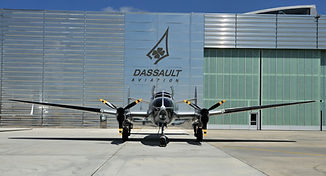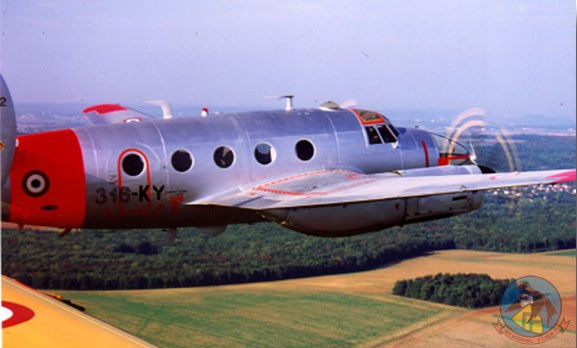

Dassault MD 311 Flamant
Airworthy restoration (Now in static display at Dassault Aviation Bordeaux-Mérignac factory)
As soon as he was freed from a concentration camp in 1945, Marcel Bloch changed his name into Marcel Dassault and returned to designing aeroplanes. Among them was a light twin-engined trainer for French Air Force pilots, navigators and bombardiers with an additional liaison or survey role. The first flight of the prototype took place on March 29th 1948 from Bordeaux-Mérignac airport with Rozanoff, Briand and Dillaire as crew.
Note: 3 versions of the Flamant were built:
-
MD 311 glazed nose, single pilot used for navigation and bomber training, production: 40.
-
MD 312 metal nose, dual control for pilot training, production: 118.
-
MD 315 metal nose, single pilot and armed, production: 137.
The first machines were delivered to the Armée de l'Air (French Air Force) in 1951 and some machines were still in service in 1982.
The Dassault MD 311 Flamant n°282

Number 282 was assigned to the Ecole de l'Air in 1953 for navigator and bombardier training. It was then transferred to the navigator training school at Avord.
The aeroplane was donated to the Association in 1987, restored to flying condition and it flew again in 1989. It is now flying in the markings of its last French Air Force assignment, G.E 316 when stationed in Toulouse (southern France).
Number 282 was the last Flamant in service in the French Air Force, serving until 1982.
The MD 311 Flamant #282 has been grounded for a few years, and is now on static display in front of the factory where it was built, at Dassault Aviation in Bordeaux-Mérignac.
Dassault MD 311 Flamant n°282 : Back to origins

In September 2010, the head of the Dassault Aviation’s site in Mérignac, near Bordeaux, decided to acquire a Flamant MD 311 in order to illustrate the aircraft that initiated the creation of this factory. Indeed, the "Flamant" (which means Flamingo in French) program allowed to launch the construction of the first building of this plant in 1946. The goal was to present this aircraft in static display inside the factory in front of the workshop where it was built and assembled. It was also decided that the restoration of the chosen aircraft would have to be carried out by a team of volunteers working in the Mérignac factory. After some research, Memorial Flight's aircraft was chosen. Our MD 311 had been grounded for a few years. Thus, the decision to sell it was made in October 2010. This aircraft was interesting because it was the last Flamant to be operated by the French air force.
The aircraft was disassembled in December 2010, and then took the road to Bordeaux, in early January 2011.
The restoration began in late January, allowing enough time to set up the required means and to set up the “Groupe Flamant” (Flamant Group), naming the team of volunteers which quickly reached the number of 35 members.
The first step consisted in establishing a precise report of the restoration tasks to be realized to lead to the best possible static display. It was decided that the aircraft should be installed on a central pedestal fixed on the wing spars, with the landing gear retracted and a slight banking angle and angle of attack. The aircraft will be enlightened at night using all its internal and external electrical systems. To the big surprise of the electricians who assigned themselves to this task, all the electric circuits of the aircraft were in operating order and could be thus re-used.
The second step was to disassemble the aircraft. The team started by removing the perspex that had to be replaced, and all the hatches and doors needed to carry out an anti-corrosion treatment in order to ensure the best structure conservation. Actually, this structure happened to be in a surpisingly good state considering the age of the aircraft, with very few repairs to be made.
At the same time, the wings were prepared for reassembly as well as the empennage, engines and propellers. This step was completed in March. At the same time, the flight controls were locked with non-visible devices from the outside.
Once the aircraft was reassembled, the new perspex were mounted, and it was prepared for painting. It was decided to apply the paint scheme that it wore between 1953 and 1965 when it was issued to the instruction group of Avord to train navigators and bombardiers.
For more authenticity, a copy of the Norden bombsight was modelled in CAD from an original one. A copy was then produced and installed in the aircraft's glass-nose. To complete the display, the modern antennas installed in the late use of the aircraft were removed, associated openings were sealed, and a copy of the original HF antenna system, which equipped the aircraft at that time, was installed.
Once the Flamant was painted, special care was paid to the final details.
A test assembly between the pedestal and the aircraft revealed some difficulties. This was not a surprise, as this was the first time a Flamant was fixed in this way. Of course, It had been decided to do the test assembly inside the workshop rather than on its final location in order to solve any problem. Everything went well at last, and the landing gear could be removed and the undercarriage doors definitively closed.
The restoration 1987-1989 (by Memorial Flight)
Airplane details
Photoscope
Cockpit and bombardier position.
Photo album
The MD 311 Flamant n°282 when it was flying among the Memorial Flight fleet.
The restoration by the "Groupe Flamant" 2010-2011 (Dassault Aviation)
Photo album of the last adventure of the former Memorial Flight Dassault MD 311 Flamant. It found a prestigious home, now being displayed on its birthplace : the Dassault Aviation factory of Bordeaux Merignac. The airplane was painted back to its first operational paint scheme thanks to a devoted group of volunteers from the factory.
Specifications
Length: 12.78 m
Wingspan: 20.21 m
Height: 4.90 m
Surface: 47.2 m²
Weight: 6400 kg
Engine: 2x 600hp SNECMA 12 T
Speed: min. 80 kts - max. 240 kts
Endurance: 4 h 15
Crew: 5
Armament: 10 ALKAN bomb racks (9 aircrafts were modified to fire Air-Ground AS 11 missiles)
Pressbook
Article: Le vol du Flamant gris / Aviasport décembre 1993 (French), 3 pages



Article: A rare performer / Flypast Airshow ' 96 (English), 2 pages






























